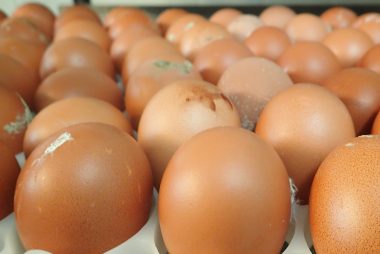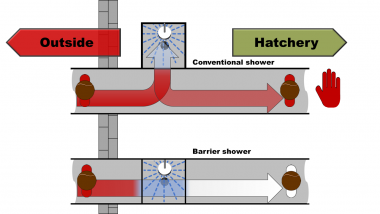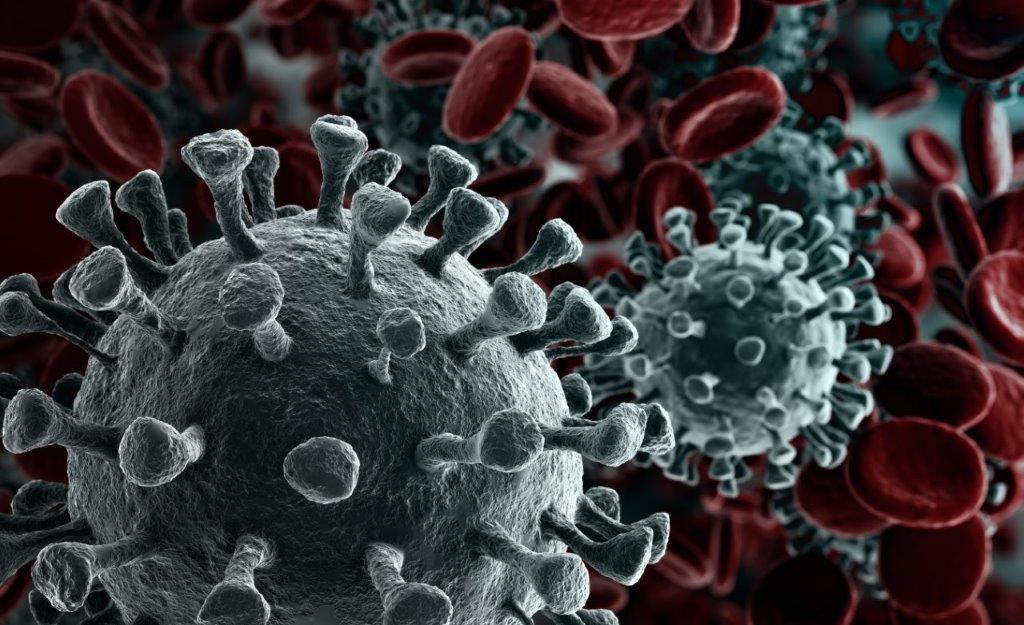Biosecurity, by simple definition, is a set of procedures undertaken to limit the spread of infectious pathogens to a susceptible population. It is, however, more than that. Biosecurity is a mindset, a way of assessing and reacting to potential risks. And it is the right mindset combined with the right procedures that will guard your hatchery against biosecurity threats.
By Petersime Hatchery Specialist Team
Develop a biosecurity mindset at the hatchery
In successful hatchery operations, everything starts with biosecurity. There are procedures and protocols that need to be followed. But, in fact, biosecurity is more than that. It is a mindset, not just a series of actions. Fostering a biosecurity culture is important to its long-term success. Every employee in the hatchery needs to understand why strong biosecurity procedures are critical to the hatchery’s success. When hatchery staff members know the underlying importance, they are likely to be more engaged in how they can take specific actions. The recent, widespread COVID-19 pandemic has all helped us to understand this better: it is about the determination to do the right thing in order to protect people, livestock, etc.
Four risk factors
To establish an efficient and effective biosecurity procedure, it makes sense to invest in the highest risks that are within your control. For this reason, we will look at four vectors that can bring pathogens into your operations. Once you know what the vectors – or risk factors – are, you can take appropriate measures to limit the chance of introduction into your hatchery:
- Incoming eggs
- People
- Site access
- Other animals
1. Incoming eggs
A first ‘threat’ is in the eggs coming from the farm. Some diseases can be transmitted to the egg whilst it is still in development within the oviduct. This kind of transmission is called ‘true vertical transmission’. Weekly testing of breeder flocks can alert you to such diseases. This allows you to pull eggs from a flock that may be infected, prior to transferring them to a hatcher, as once the birds start hatching, they can start spreading the disease.
‘Apparent vertical transmission’ is contamination on the surface of the egg. Soiled eggs should never come into the hatchery, as they contain a huge bacterial and viral threat. Also, any faecal matter or feathers on the surface of the eggs can be drawn into egg transfer heads, which can lead to cross-contamination of other A-grade eggs. This is why only clean nest eggs should be used and an early fumigation should be done on the farm to reduce bacterial levels.

‘Apparent vertical transmission’, or contamination on the surface of the egg, is to be avoided at all times.
2. People
People are a high-risk factor in spreading disease from one location to another. To prevent this from happening, you can introduce a few simple, yet very effective practices into your hatchery:
- Provide biosecurity training courses for all employees. New staff should be trained immediately. Annual refresher training courses are advisable.
- Don’t allow employees to own (or interact with) avian species or visit wet markets and other high-risk locations for avian diseases, due to the risk of disease transmission. Physical contact with wild birds and hunting wild birds should also always be avoided.
3. Site access
Proper measures are needed to prevent unauthorised access to the hatchery and ensure adequate biosecurity control on site:
- Fence off the premises with clear signage and control the entry and exit points.
- Maintain a visitor record and have all visitors answer a questionnaire upon arrival to screen for biosecurity risks. Include questions about ‘reason for visit’, ‘last avian site visited’, ‘date of visit’ etc., for traceability in the event of a disease breakout.
- All personnel entering the hatchery should pass through a barrier shower, a one-way shower system that eliminates re-contamination of dedicated clothing (not possible with a conventional shower).
- Have hand sanitisers available on every doorway, as hands should be sanitised when entering and leaving all individual rooms (both on the egg and chick side of the hatchery and especially the canteen).
- Any equipment coming into the hatchery should be sanitised, either by using an ultra-violet chamber or a sanitiser spray.
- Split the hatchery into three sectors – egg sector, chick sector and external sector – to keep those who work in the different sectors separated. Using colour-coded uniforms makes identification of personnel easier and helps restrict personnel movement.
- When buying new equipment, also look at it from a biosecurity perspective. Certain equipment minimises biosecurity risks better than other: no dirt traps, easy and high-pressure cleaning, etc.

A barrier shower eliminates re-contamination of dedicated clothing.
4. Other animals
All other animals (apart from avian species) also form a risk of disease introduction. Fortunately, most of these animals can easily be prevented from entering. The greatest threats are rodents and wild birds:
- Maintain an effective rodent combat programme: keep potential food sources in plastic boxes (not cardboard) and place rodent bait stations on the outside, as well as on the inside of the hatchery.
- Keep wild birds out by putting up netting.
COVID-19: some common-sense precautions
Health experts are predicting that the COVID-19 pandemic will have an ongoing global impact. That is why it is advisable to take following common-sense precautions on top of your standard (biosecurity) procedures:
- Increase the training levels on biosecurity.
- Cross-train staff so different people can carry out different functions in case some of your employees would have to go into self-isolation. Don’t forget to include Maintenance and First Aid, as they are crucial to any hatchery.
- Put an even increased focus on (hand) hygiene: wash hands, disinfect them regularly, avoid touching eyes, nose and mouth, etc.
- Ensure essential spare parts are in stock.
- Have internet installed in the hatchery building(s). This might come in handy for direct remote support from specialists when needed.
It is vital that you ensure all your staff members know and follow the biosecurity procedures issued for your hatchery, and, even more importantly, understand the underlying importance of these procedures. It is the right mindset combined with the right procedures that will guard your hatchery against biosecurity threats.






